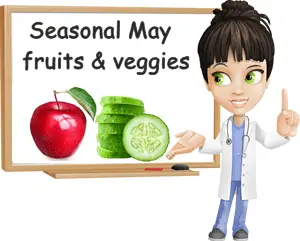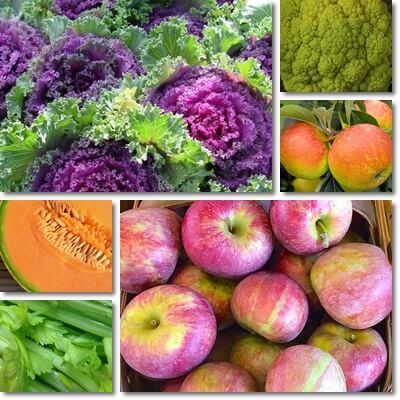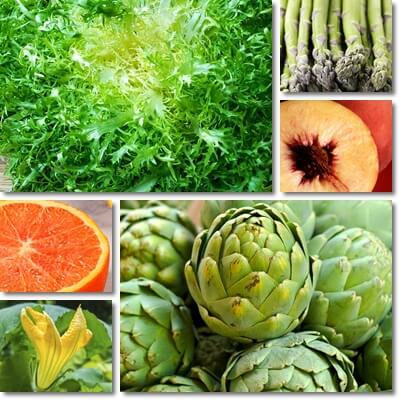There is an abundance of fruits and vegetables that are in season in May, whether they are original seasonal foods or off-season foods that are available all year round, the month of May included. Regardless, May fruit and vegetables are all healthy, not necessarily in the same way, and provide much needed variety and nutrition to one’s diet.
List Of Fruits and vegetables in season in May
Agretti
Agretti is a healthy May vegetable with a detoxifying action, laxative effects and anti-aging benefits. It’s also called agretti salad, barilla plant or Salsola soda and has an acidic and salty taste with grassy flavor notes. Its name literally means sour or sharp tasting. Find out more about the benefits of agretti.

Apples
Apples are available year round, not just in May. The off-season fruit is good to eat for nausea because of its content of organic acids such as malic acid which exert a restorative action and have appetite restoring benefits.
Artichoke
Artichokes are a true spring seasonal food and they are in full season in May. Artichoke season continues summer through fall. You can eat artichokes as vegetables or use artichokes leaves to make artichoke tea with benefits for high cholesterol and weight loss.
Arugula
Also known as rocket salad, arugula is one of the best tasting spring salads available in May. Arugula has a high content of vitamins A and K with benefits for the immune system and antibleeding effects. It’s also a good source of vitamin C with scientifically proven anti-inflammatory and antiaging properties.
Asparagus
Of all the vegetables in season in May, asparagus is one of the finest. Choose between the more common green asparagus, white or pink asparagus and purple asparagus varieties and boost your intake of vitamins A, K, B vitamins and pigmented antioxidants with proven anti-inflammatory and anticancer effects.

Avocado
Avocado is available all year round from different regions and one of the healthiest fruits you can eat in May. The good magnesium and potassium content of avocado, and healthy unsaturated fats, recommend it for cardiovascular health, with benefits for high blood pressure and high cholesterol.
Bananas
This May eat bananas for a boost in your vitamin B6 levels and benefits for anemia, fatigue and muscle weakness. Bananas further provide small amounts of iron and have a good content of vitamin C to boost iron absorption for a revitalizing action and additional anti-anemia benefits.
Bell peppers
Bell peppers are in season in May, and the rest of the year too. Raw bell peppers are one of the best food sources of vitamin C of all common foods for lower inflammation levels and more youthful skin. Bell peppers also have a good content of vitamin B6 which helps produce hemoglobin and boosts the capacity of hemoglobin to absorb oxygen for anti-anemia action.
Blueberries
May is a good time for blueberries which become readily available in grocery stores, supermarkets and farmers’ markets. Blueberries are high in dark pigmented anthocyanin antioxidants with scientifically proven anti-inflammatory and anticancer effects.
Brussels sprouts
Eat Brussels sprouts this May to boost your intake of vitamins C and K with anti-inflammatory, antioxidant, anticancer and antibleeding effects. Brussels sprouts further exert prebiotic benefits, help lower blood pressure and contribute to good bone mineral density and energy metabolism.
Bulb onions
Bulb onions are in season all year round, May included, and a source of anticancer benefits – natural sulfur compounds in bulb onions exert antiproliferative, apoptosis-inducing and reparative effects at cell level, lowering cancer risks. Choose red onions for a boost in anthocyanin levels and added anticancer benefits.
Cabbage
This May eat cabbage raw to up your daily intake of vitamin C and enjoy anti-inflammatory benefits. Eat it pickled for good gut health, or any way you want it and get lots of vitamin K, vitamin B6 and vitamin B9 with benefits for bone mineral density, anemia and energy metabolism.
Cantaloupe
May is a good season for cantaloupe. Eating cantaloupe lowers levels of an inflammation marker in the body called C-reactive protein. Cantaloupe helps improve transit time and relieves constipation, as well as provides carotenoid antioxidants with benefits for eyesight.
Carrots
Carrots of all colors have a good content of vitamin B6 which helps produce hemoglobin and boosts the capacity of hemoglobin to absorb oxygen, actively helping combat anemia, fatigue and muscle weakness. Orange and yellow carrots are especially good for eyesight, while purple and black carrots have anticancer properties.
Cauliflower
Cauliflower is originally a winter seasonal vegetable, but is cultivated extensively and stores so well that it’s in season in May too. Cauliflower is a good food for weight loss diets, low in calories and satiating. Different colors provide different types of antioxidants with varied benefits for health.
Celery
While a common allergen, celery is healthy and a good vegetable to eat in May. Stalk celery and leaf celery such as Chinese celery are very low in calories and good for losing weight. Root celery is a great substitute for potatoes, and good for bone density.
Chicory and endives
Chicories and endives are essentially vegetable greens or salad greens in season winter through spring, May included. Most varieties are low in calories and make good foods to eat in a weight loss diet. Chicories and endives are also anti-inflammatory and high in antioxidants.

Collards
Readily available in May, collards are excellent greens to include in your meal plan. Eat them raw for a boost in vitamin C and anti-inflammatory benefits, or cooked and still get to enjoy lower inflammation levels from a high vitamin K content.
Cucumber
Cucumbers are one of those vegetables in season all year round. Cucumbers are a great food to eat this time of the year as they are low in calories and hydrating, perfect for raising temperatures and to lose excess weight put on during winter.
Fava beans, broad beans or fave
This Italian seasonal vegetable is available spring through early summer, depending on the region. If you can buy fava beans this May, enjoy them raw or cooked for a boost in protein and nutrition. Fava beans are high in vitamins B1, B2, B3, B6, B9, calcium, copper, iron, magnesium, manganese, phosphorus, potassium, selenium and zinc.
Garlic
Even in the small amounts it’s meant to be consumed, garlic can be a great food to include in your diet this May. With natural antibiotic properties and anticancer effects, it’s generally very good to eat unless you have an active gastritis, GERD or acid reflux disease.
Green onions, spring onions or scallions
Green onions are the first onions of the year. They are essentially underdeveloped onions, at the stage before the underground bulb grows pungent and large and the green tops dry out. Much milder than bulb onions, green onions are largely available in May and a savory and healthy seasonal vegetable to include in your diet.
Kale
While bitter tasting, kale is a great May vegetable to boost your nutritional status. It’s high in vitamins A, K and C, and has a good content of vitamins B1, B2, B5, B6 and B9. Eating kale is good for bone mineral density, providing essential minerals for healthy bones such as calcium, magnesium, manganese, phosphorus and potassium.
Kiwifruit
Kiwifruit is available year round, including in May, and it’s one of the healthiest fruits you can eat. Kiwifruit is naturally high in vitamin C which stimulates the production of collagen in the skin for better skin elasticity and antiaging benefits. Zespri SunGold golden kiwifruit is more than 50% higher in vitamin C than green kiwifruit, but green kiwifruit and kiwi berries are higher in vitamin K.
Kohlrabi
Kohlrabi is naturally a cool weather vegetable, but it’s available year-round. Kohlrabi tastes similar to broccoli, but milder, and is best eaten raw to boost your vitamin C levels and enjoy anti-inflammatory and antiaging benefits. You can slice kohlrabi thinly and add it raw to salads, paired with other seasonal or off-season foods readily available in May.
Lamb’s lettuce
Lamb’s lettuce, corn salad or valerian salad is a seasonal spring salad green, ideal for a weight loss diet. It has only 19 calories per 100 grams, a pleasant green taste with no bitter flavors, and a good content of fiber and vitamin C.
Lettuce
Lettuce is readily available in May, present everywhere from supermarket shelves to farmers’ markets. The seasonal spring vegetable is very low in calories and has a good content of vitamin B9 and iron for a boost in energy levels and vitality.
Lovage
Decidedly fragrant and the best pair for beans, lovage is a culinary herb in full season in May. Lovage is naturally anti-inflammatory, and rich in aromatic oils with soothing effects for stomach stomach upset and bloating.
Mango
While they do have a season, mangoes are pretty much available all year round, with May being a good time to enjoy them. Mango is especially good to eat for its high content of vitamin C, and good content of vitamins B6, B9 and A.
Mushrooms
There are quite a few different types of mushrooms in season in May. White button mushrooms, portobello mushrooms and cremini or crimini mushrooms are readily available, but local species are also abundant starting April-May. Go for farmed mushrooms to boost your intake of vitamin D.
Nectarines
Nectarines are a variety of peaches without fuzz. They are extremely sweet and juicy, with a strong fruity scent, one of the best tasting fruits to eat. May is a great time for nectarines and, while modestly nutritious, they are rich in antioxidants.
Nettle
May is last call for spring nettle. Late season nettle available in May is scarce, but nonetheless a healthy option. Cooked nettle is mucilaginous, with fresh green flavors, great for relieving constipation and regulating transit. It’s also easy on the stomach and a good food to eat for gastritis and acid reflux. You can also dry nettle leaves and save them to make nettle tea the rest of the year.
Oranges
Oranges are pretty much available all year round, but different varieties are naturally in season at different times of the year. Navel oranges, tangerines or tangerine oranges and tangelos are the most prominent orange varieties in season in May. The good content of potassium in oranges and the slightly better content of potassium in orange juice recommend them for consumption for high blood pressure, while carotenoid antioxidants in the fruit and fruit juice boost eye health.
Parsnip
Naturally a winter through spring vegetable, parsnip is now available in May as well. Although bland tasting, parsnip is just as healthy as carrots. Parsnip contains chemicals such as falcarinol, farcalindiol, methyl-falcarindiol and panaxydiol with scientifically proven anticancer properties.
Parsley
Parsley is never not available. Fresh parsley is an extreme source of vitamin K with anti-inflammatory benefits, and high in vitamin C with antiaging effects. It’s high in iron, potassium and vitamins A and B9.
Patience dock
Patience dock or monk’s rhubarb is a spring seasonal vegetable that is primarily available as forage material. In season early March through late May-early June, it’s a great source of pro-vitamin A with benefits for eyesight and skin, and vitamin K with anti-inflammatory and antibleeding benefits
Peaches
May is a great month for peaches. Sweet and fragrant and juicy, peaches are hydrating, but contribute modestly to daily nutritional requirements. They are however rich in antioxidants, especially peach skin.
Plums
Plums sourced from warmer regions are taking over the market starting May. With a good content of dietary and vitamin C, plums contribute modestly to daily nutrition. They are however rich in pigmented anthocyanins, antioxidants with scientifically proven anti-inflammatory and anticancer effects.
Potatoes
Both last season potatoes and ‘new potatoes’ that have just been harvested are readily available in May. The good content of potassium in potatoes recommends them for high blood pressure. Potatoes further provide good amounts of vitamin B6 with benefits for tiredness, fatigue, muscle weakness and anemia.
Radicchio
Radicchio is a variety of chicory popular in Italian cuisine and in season winter through spring, May included. Its defining feature is its color: white with deep red-purple. Radicchio di Chioggia looks like a smaller red cabbage, while radicchio di Treviso is shaped like an endive, but with red-purple coloring. Radicchio is good for high blood sugar levels, promotes weight loss and has digestive benefits.
Radishes
Radishes are in season year long, and readily available in May. The spring seasonal vegetable is very low in calories which makes it ideal for weight loss diets. Studies show pink and red radishes help lower blood sugar levels and are good to eat for diabetes.
Raspberries
Early season raspberries are available in May and add variety to the diet. Raspberries have been found to contain a natural chemical with antiaging effects called Urolithin A. The fruit are low in calories and good to eat for losing weight. Yellow raspberry varieties are good for vision, while purple raspberries and black raspberries have anticancer properties.
Rhubarb
In the Northern hemisphere, rhubarb is in full season in spring, April-May being peak season. Rhubarb has a good content of vitamin K with anti-inflammatory and antibleeding effects, as well as calcium and manganese with benefits for bone mineral density.
Spinach
Spinach is in season in May and the rest of the year. Baby spinach is low in oxalates and can be eaten raw, while mature spinach leaves are best cooked to cancel their antinutritional action. Spinach is an anti-inflammatory food with benefits for muscle cramps, high cholesterol and high blood pressure. If you have gastritis or acid reflux disease, cooked spinach is one of the best foods you can eat.
Spring peas
Spring peas are readily available all of May and a great addition to any diet. They provide good amounts of both fiber and protein to the diet, with benefits for digestive health, muscle mass and weight loss. Eating spring peas boosts levels of iron, manganese and B vitamins for good energy levels and vitality.
Strawberries
Strawberries are available year round, but May is a natural season for them. Strawberries have a good content of vitamin C and manganese with benefits for fertility and antioxidant benefits. They are low in calories and have a low glycemic index score, with minimal effects on blood sugar.
Sweet potatoes
In season all year round, sweet potatoes are generously available in May. Choose orange-fleshed sweet potatoes for pro-vitamin A carotenes with benefits for eyesight and immunity. Go for purple sweet potatoes and red sweet potatoes for anthocyanin antioxidants with scientifically proven anticancer properties.
Tomatoes
Tomatoes are in season all year round, and naturally in season in May. Tomatoes are a good food to eat for weight loss, and have anti-hypertensive benefits. All colors are rich in antioxidants: there are lycopene and other carotenes in red tomatoes, lutein and zeaxanthin in yellow tomatoes and anthocyanins in blue, purple and black tomatoes.
Wild garlic
Wild garlic is a popular forage green in season February through May. Wild garlic has the same benefits as garlic and onions to which it’s related, but is milder and gentler on the stomach which makes it good for anyone who cannot tolerate the pungency of bulb garlic and bulb onions.
Zucchini
Zucchini, also called courgettes, are readily available in May. Essentially an unripe summer squash, zucchini has prebiotic properties and regulates transit for constipation relief. It’s good for high cholesterol and weight loss, and a safe food to eat if you have gastritis or acid reflux disease.
Zucchini flowers
In certain parts of the world, zucchini plants are just blossoming in May. Zucchini blossoms, or flowers, are edible and perfectly safe to eat. You can eat them raw (tossed in a salad) or cooked (baked, fried in batter, boiled in soups), and they are very low in calories and low glycemic. You can eat zucchini flowers with diabetes, high cholesterol, gastritis and acid reflux disease.
